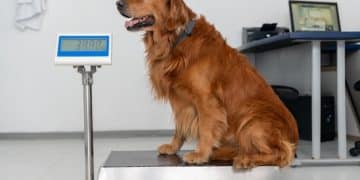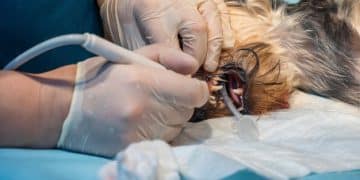Is Your Pet Overweight? Body Condition Score & Weight Loss Plan
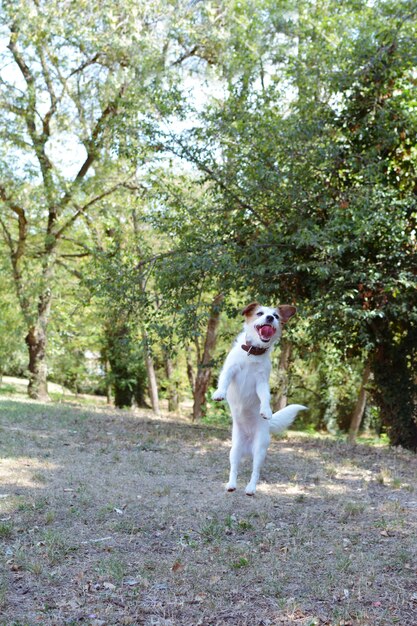
Is your pet overweight? Learn how to calculate their Body Condition Score (BCS) and create a personalized weight loss plan to help them achieve a healthy and happy life.
Is your furry friend looking a little…fluffy? Just like humans, pets can struggle with their weight. But unlike us, they rely on us to help them stay healthy. Determining **is your pet overweight? Calculate their Body Condition Score and get a personalized weight loss plan** is crucial for their well-being and longevity.
Understanding Pet Obesity
Pet obesity is a prevalent issue in the United States, mirroring the human obesity epidemic. Overweight pets are at a higher risk for several serious health conditions, reducing their quality of life and lifespan. Recognizing the signs of obesity and understanding its causes are the first steps towards helping your pet achieve a healthy weight.
Prevalence of Pet Obesity
Studies show that a significant percentage of dogs and cats in the US are overweight or obese. This alarming statistic underscores the importance of proactive pet weight management.
Health Risks Associated with Pet Obesity
Obesity in pets can lead to a range of health problems, including:
- Arthritis and joint pain
- Diabetes
- Heart disease
- Breathing difficulties
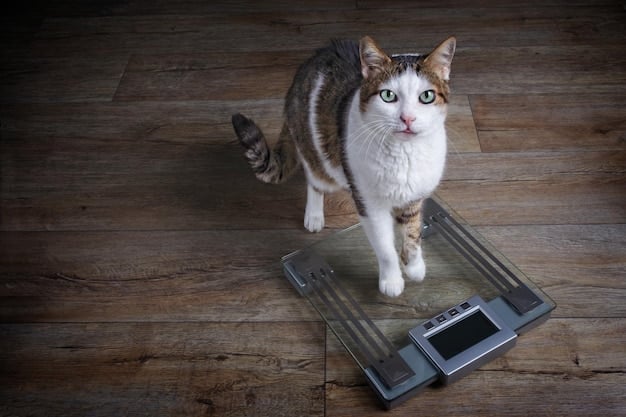
Addressing these risks through proper diet and exercise can significantly improve your pet’s overall health and well-being.
In conclusion, understanding the prevalence and risks associated with pet obesity is essential for responsible pet ownership. By taking proactive steps, you can help your pet live a longer, healthier, and happier life. Monitoring your pet’s weight and consulting with your veterinarian are crucial components of preventative care.
What is the Body Condition Score (BCS)?
The Body Condition Score (BCS) is a standardized system used by veterinarians and pet owners to assess a pet’s weight. It’s a hands-on evaluation that considers both visual cues and tactile feedback to determine if a pet is underweight, ideal weight, overweight, or obese.
How BCS Works
The BCS system typically uses a scale, often ranging from 1 to 9, where:
- 1-3 indicates underweight
- 4-5 represents ideal weight
- 6-7 suggests overweight
- 8-9 signifies obesity
Assessing Your Pet’s BCS
Here’s how to assess your pet’s BCS:
- Rib Palpation: Gently feel your pet’s ribs. You should be able to feel them easily without pressing hard, but they shouldn’t be prominently visible.
- Waistline: Look at your pet from above. They should have a visible waistline behind the ribs.
- Abdominal Tuck: View your pet from the side. Their abdomen should tuck up towards their hind legs.
Using these guidelines, you can get a better understanding of your pet’s current weight status.
In summary, the Body Condition Score is a valuable tool for pet owners to evaluate their pet’s weight and overall health. By understanding how the BCS system works and how to assess your pet, you can take proactive steps in managing their weight and ensuring their well-being.
Calculating the BCS for Dogs
Calculating the Body Condition Score for dogs involves a visual and physical assessment. Focusing on key areas such as the ribs, waistline, and abdominal tuck will provide an accurate idea of your dog’s weight and help you determine if they are at an ideal weight, overweight, or underweight.
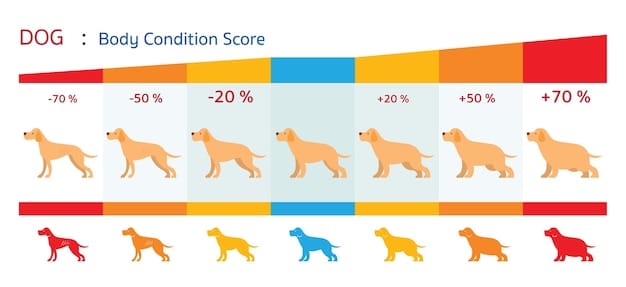
Rib Assessment
The ribs should be easily palpable with minimal fat covering. If the ribs are highly visible and the dog lacks muscle mass, they are likely underweight. If you can’t feel the ribs without applying significant pressure, your dog is probably overweight.
Waistline Evaluation
Looking from above, your dog should have an obvious waistline behind the ribs. An absence of a waistline suggests that your dog is carrying excess weight. The shape of the waistline is also important; it should be proportional to the dog’s breed and build.
- Ideal: Easily discernible waistline.
- Overweight: Minimal or no waistline.
- Underweight: Exaggerated waistline with prominent hip bones.
These simple checks can help you accurately gauge your dog’s BCS and make informed decisions about their diet and exercise regimen.
In conclusion, calculating the BCS for dogs requires a combined assessment of rib palpation, waistline evaluation, and abdominal tuck observation. Regular monitoring and adjustments to your dog’s diet and exercise based on their BCS will contribute significantly to their overall health and longevity.
Calculating the BCS for Cats
Just as with dogs, calculating the Body Condition Score for cats requires careful observation and palpation. As a cat owner, you may wonder if your feline friend is at their optimal weight. Evaluating the ribs, waistline, and abdominal area will give you a comprehensive understanding of your cat’s BCS and help you determine if they need to gain or lose weight.
Rib Palpation in Cats
The ribs should be felt easily under a thin layer of fat. If the ribs are too prominent and the cat appears bony, they are underweight. Conversely, if you can’t feel the ribs without considerable pressure, your cat is likely overweight.
Waistline Observation
When viewed from above, your cat should have a noticeable waistline behind the ribs. A straight or bulging appearance suggests that your cat is carrying too much weight. A severely pinched waistline indicates that the cat may be underweight.
When assessing the abdominal tuck, remember that consistency in your evaluation method is key to accurate BCS monitoring.
- Ideal: Noticeable waistline and abdominal tuck.
- Overweight: Minimal waistline and rounded abdomen.
- Underweight: Exaggerated waistline and prominent hip bones.
In summary, accurately calculating the BCS for cats involves thorough assessment of the ribs, waistline, and abdominal tuck. By regularly monitoring your cat’s BCS, you can ensure that they maintain a healthy weight and enjoy a better quality of life.
Creating a Personalized Weight Loss Plan
Once you’ve determined that your pet is overweight using the Body Condition Score, the next step is to create a personalized weight loss plan. A successful plan involves a combination of dietary adjustments, increased physical activity, and regular monitoring.
Dietary Adjustments
The cornerstone of any weight loss plan is diet. Here are some considerations:
- Calorie Reduction: Work with your vet to determine the appropriate daily caloric intake for your pet.
- High-Quality Food: Choose a high-quality pet food that is rich in protein and fiber to promote satiety.
- Measured Portions: Avoid free-feeding. Measure out each meal to ensure you are not overfeeding your pet.
Exercise and Physical Activity
Increasing your pet’s physical activity is crucial for burning calories and improving overall fitness.
Remember that consistency and patience are key to a successful weight loss journey for your pet.
- Regular Walks: For dogs, aim for daily walks, gradually increasing the duration and intensity.
- Playtime: Engage in interactive play with your cat, using toys to encourage movement.
- Puzzle Feeders: Use puzzle feeders to make mealtime more engaging and active.
In conclusion, creating a personalized weight loss plan for your pet involves careful consideration of dietary adjustments and physical activity. By working closely with your veterinarian and staying consistent with your plan, you can help your pet achieve a healthier weight and improve their overall quality of life.
Monitoring Progress and Adjusting the Plan
Monitoring your pet’s progress is essential to ensure that the weight loss plan is effective and safe. Regular check-ins and adjustments can help you fine-tune the plan as needed, addressing any challenges or setbacks along the way.
Regular Weight Checks
Weigh your pet regularly, ideally every one to two weeks. Keep a record of their weight to track progress. Remember that weight fluctuations are normal, but a consistent downward trend is what you’re aiming for.
Reassessing the BCS
Periodically reassess your pet’s Body Condition Score. This will provide a more comprehensive view of their progress and help you determine if the plan is working effectively.
- Adjustments: If your pet isn’t losing weight, consider further reducing their calorie intake or increasing their physical activity.
- Consult Your Vet: Always consult with your veterinarian before making any significant changes to your pet’s diet or exercise routine.
In summary, monitoring progress and adjusting the plan are crucial steps in helping your pet achieve and maintain a healthy weight. Regular weight checks, reassessing the BCS, and consulting with your veterinarian will ensure that the weight loss journey is safe and effective.
| Key Point | Brief Description |
|---|---|
| 📏 BCS Assessment | Evaluate ribs, waistline, and abdominal tuck to determine body condition. |
| 🥗 Diet Adjustment | Reduce calorie intake and choose high-quality, portion-controlled food. |
| 🐾 Increased Activity | Incorporate regular walks, playtime, and puzzle feeders. |
| 📅 Regular Monitoring | Track weight and reassess BCS, consulting with your vet for adjustments. |
Frequently Asked Questions
▼
It’s recommended to check your pet’s BCS at least once a month to stay on top of any weight changes. This helps in addressing potential issues early on.
▼
Human food is generally not recommended. It often lacks the specific nutrients pets need. Consult your vet for suitable, balanced options tailored for pets.
▼
Weight loss should be gradual. Aim for 1-2% of body weight loss per week to ensure it’s a healthy and sustainable process, avoiding any health risks.
▼
Yes, certain breeds like Labrador Retrievers, Dachshunds, and Persian cats have a higher predisposition for weight gain. Awareness helps in preventative measures.
▼
Treats should be limited as they add extra calories. When used, opt for healthy, low-calorie options and factor them into the daily caloric allowance.
Conclusion
Determining if your pet is overweight and creating a personalized weight loss plan is a crucial step in ensuring their long-term health and happiness. By utilizing the Body Condition Score (BCS), making appropriate dietary adjustments, increasing physical activity, and regularly monitoring their progress, you can help your furry friend achieve and maintain a healthy weight. Always consult with your veterinarian for personalized guidance and support throughout this journey.


